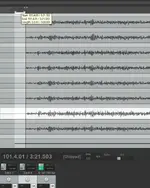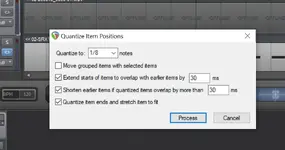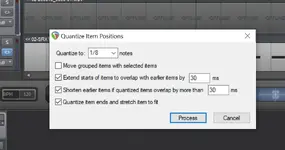You are using an out of date browser. It may not display this or other websites correctly.
You should upgrade or use an alternative browser.
You should upgrade or use an alternative browser.
gecko zzed
Grumpy Mod
Start Reaper using the start-up option that resets to factory defaults, then try again, i.e. let Reaper sort out the latency compensation automatically.
LazerBeakShiek
It is a life preserver
After unplugging the interface and restarting, I got a ridiculous 832 samples offset from the ping.
Entering that number in the offset window totally messed things up.
Default settings it is 10/3 ms of latency, and I work with it nudging tracks.
Entering that number in the offset window totally messed things up.
Default settings it is 10/3 ms of latency, and I work with it nudging tracks.
TalismanRich
Well-known member
Yeah, my tracks dont line up like that at all.
I was told that 10 ms is not noticeable, but it REALLY is.
My ping shows 0, so either it does not work or its that awesome. I dont know. I dont have computer skills. So if it dont work, it dont work.
Does it make a big difference in your playing if you walk 10 ft from the drummer vs standing 1 foot away from him? That's 10ms of delay.
As for getting a ping of 0, that's probably operator error. If the system shows there's latency (and ALL systems have latency) then you won't measure zero.
As I said, when I tried plugging in numbers, my stuff got screwed up, so I let Reaper handle it and it works just fine.
LazerBeakShiek
It is a life preserver
Here is played notes on a midi controller. My X6. Input as audio, tapping the C note there is more latency compensation than is needed. Playing the midi controller, as midi device, the tapping synchronization of the C note is not as bad.

I can tap a single note to a rhythm, I swear I can.
This time instead of 3.8 its 4.5ms latency. Is that number supposed to stay constant?

I can tap a single note to a rhythm, I swear I can.
This time instead of 3.8 its 4.5ms latency. Is that number supposed to stay constant?
TalismanRich
Well-known member
I seriously doubt that you could maintain accuracy of 4ms if you are tapping notes to a beat. 4 milliseconds is 4 THOUSANDTHS of a second. I have actually tested people using stopwatches (we used stopwatchs to time tests in a laboratory) and most people were good to 2-4 hundredths of a second. Since we were going for ISO 9000 certification, we had to know the reproducibility of test results. Gauge R&R studies said that we could RELIABLY report 1/10sec.
If you really want to test it, set up the Midi controller to PLAY a note and record the audio. I did this recently putting 8 mics ~1 foot in front of one of the monitors. (this was in another thread) I then played the clicks and recorded the notes. They were one millisecond behind the click which is completely logical since sound travels at 1 ft/ms.
Here was the screenshot. This was after 3 minutes of recording, and was exactly the same as at the first beat. What I found MORE interesting was that the wave forms varied so much. These were 4 pairs of SDC mics. Rode M5, Lauten LA120, CAD 1200xl and AKG P170.
If you really want to test it, set up the Midi controller to PLAY a note and record the audio. I did this recently putting 8 mics ~1 foot in front of one of the monitors. (this was in another thread) I then played the clicks and recorded the notes. They were one millisecond behind the click which is completely logical since sound travels at 1 ft/ms.
Here was the screenshot. This was after 3 minutes of recording, and was exactly the same as at the first beat. What I found MORE interesting was that the wave forms varied so much. These were 4 pairs of SDC mics. Rode M5, Lauten LA120, CAD 1200xl and AKG P170.
Attachments
LazerBeakShiek
It is a life preserver
Man, this stuff fascinates me.
Those 8 mic's are at .001 scale? They look straight to me.
Your comment about keeping time insinuates that..I have zoomed in on the time scale until I can see my own faults?
Those 8 mic's are at .001 scale? They look straight to me.
Your comment about keeping time insinuates that..I have zoomed in on the time scale until I can see my own faults?
TalismanRich
Well-known member
Yeah, I have zoomed in as far as I could. Someone was concerned about drift in the latency. Turn off the snap to grid and you can do the selection to determine exactly how far off two spots are from each other. See at the top, it says length .001 seconds. This is after 3:21.502 minutes of recording. I looked through the whole file and they were all the exact same.
As for faults.... well, lets just say that if you had ever played with our old drummer, you would understand that +/- a few tenths of a second was a good beat. Or just skip a few beats. Speed up/Slow down. There's a beat there somewhere!
I find that when I practice alone, I'm all over the place. That's not good when you want to play with others. When I throw on a click track, or better yet, turn on a drum machine, it really helps me.
As for faults.... well, lets just say that if you had ever played with our old drummer, you would understand that +/- a few tenths of a second was a good beat. Or just skip a few beats. Speed up/Slow down. There's a beat there somewhere!
I find that when I practice alone, I'm all over the place. That's not good when you want to play with others. When I throw on a click track, or better yet, turn on a drum machine, it really helps me.
LazerBeakShiek
It is a life preserver
TalismanRich
Well-known member
Have you used the Quantize function on the analog tracks? A click is good, how about a keyboard that is set to auto-quantize. It will play the notes forced to master tempo.
Never. That won't help when I play with another person. Plus, sometimes it works to play behind the beat a bit, I'm not looking to record "perfect". FWIW, I would gladly use a live drummer, it I had one, and he was willing to be there at 11 at night when the mood strikes me, or 9 in the morning. Instead, I'm working with MT PowerDrummer and my SR18. They don't care what time it is, or drink up all my bourbon!
gecko zzed
Grumpy Mod
After unplugging the interface and restarting, I got a ridiculous 832 samples offset from the ping.
Entering that number in the offset window totally messed things up.
Default settings it is 10/3 ms of latency, and I work with it nudging tracks.
That's not what I meant when I suggested starting Reaper with the factory reset option. Or were you trying something different?
If, somehow, Reaper's latency control has been messed up, then unplugging and restarting the interface will not help, because that won't affect Reaper's settings.
LazerBeakShiek
It is a life preserver
Zzed, Thanks . Have you tried the quantize function in Reaper by chance?
The idea of Reaper automatically fixing the problem seems possible.
The idea of Reaper automatically fixing the problem seems possible.
Last edited:
LazerBeakShiek
It is a life preserver
Could you check and see if the Auto-quantize process magically nudges an analog track to midi tempo? It should, but does not for me. Reaper should look at peaks in the waveform, and move the *wav over, quantifying it to the master tempo BPM. It does for midi information.
Attachments
gecko zzed
Grumpy Mod
I've played with most of Reaper's functions. Audio quantizing not so much.
But I think that is more a remedial action than a primary option. If your timing problems are a result of latency issues, that's what you need to sort out first.
But I think that is more a remedial action than a primary option. If your timing problems are a result of latency issues, that's what you need to sort out first.
LazerBeakShiek
It is a life preserver
studies said that we could RELIABLY report 1/10sec.
.
Does this sound in time? Or close enough? There are 2 P420 voices not in time perfectly so they sound phased. 1 bass. 2 guitars verse and lead. Akai MPD218 tappy drums. The more I layer instruments the more I nudge . The song has a lot going on in it.
Yes, leaving the box checked to let Reaper handle the latency it works best. I still nudge it here and there..
Edit- My mental metronome is cashed out. Either everything is in time or nothing is in time. I cannot decide right now. Playing around with latency correction did it.
I dragged the first part towards the beginning and the end part not as much I guess. There are two holes in it. I will fix tomorrow.
Craztrain by Mark C | Free Listening on SoundCloud
Attachments
Last edited:
Steve Ireland
New member
I run through a Dr J Sparrow DI pedal (Sansamp clone) and at the same time run a direct line into the interface (clean to DI 1 and dirt to Mic 2 on Audient id14). Blend to taste and bingo! ABY pedal is the EHX Switchblade.
LazerBeakShiek
It is a life preserver
That is cool Steve. That one gets many recommendations.
These instruments are from the UA Apollo, the HELIOS unison model. It is awesome. No amps, or pedals. Instrument into the Hi z. I wanted a touch of distortion in the song. So I looked in the VST JS folder in Reaper, sure enough there was a 'distortion' VST to add post. I did the blend trick with only 1 side distorted.
These instruments are from the UA Apollo, the HELIOS unison model. It is awesome. No amps, or pedals. Instrument into the Hi z. I wanted a touch of distortion in the song. So I looked in the VST JS folder in Reaper, sure enough there was a 'distortion' VST to add post. I did the blend trick with only 1 side distorted.
Last edited:
cavedog101
Well-known member
I have a bunch of bass guitar options available. In my 30+ years of tracking this particular instrument (it's the one I'm most proficient on) the ONE universal truth is this......Simple. Direct to the capture medium. The bass instrument and the player make the sound what it is. The engineer's job is to capture it as realistically as possible.
AFTER the solid, full range capture, any manipulation for a "special" effect of sound will be easily done due to the quality of the tracking. I cannot stress this enough.
I have a preamp in my rack dedicated to bass. It's an older SWR Interstellar Overdrive pre from the late 90's early 2000's. It is tube. It has EQ and lots of patching options. It is commonly put on a level with the Alembic, Demeter, and other very high-end bass pres. They weren't cheap in those days. With this and a Retro Stay-Level comp or a Grace Opto comp there's nothing it won't capture in a professional way.
If a client wants an ampI have a 1966 Ampeg B15 with a fresh speaker and recapped recently. Quiet and it IS the sound of bass on recordings for the last 50 years or more. But I still take a DI when I'm using this. An SM7 on the grill through a Neve, a U87 3 ft. out through a Manley, the DI and we're good.
It's all about the initial capture and to get that with as FEW MANIPULATIONS as possible. Every addition of something in the chain induces phase, increases latency, and lessens the chances of a finely built track.
At mix I have so little to do with the bass. It's "nearly done" at tracking. Allows me to concentrate more on the feel and how the vocals(if there are any) sit within the scheme of things.
AFTER the solid, full range capture, any manipulation for a "special" effect of sound will be easily done due to the quality of the tracking. I cannot stress this enough.
I have a preamp in my rack dedicated to bass. It's an older SWR Interstellar Overdrive pre from the late 90's early 2000's. It is tube. It has EQ and lots of patching options. It is commonly put on a level with the Alembic, Demeter, and other very high-end bass pres. They weren't cheap in those days. With this and a Retro Stay-Level comp or a Grace Opto comp there's nothing it won't capture in a professional way.
If a client wants an ampI have a 1966 Ampeg B15 with a fresh speaker and recapped recently. Quiet and it IS the sound of bass on recordings for the last 50 years or more. But I still take a DI when I'm using this. An SM7 on the grill through a Neve, a U87 3 ft. out through a Manley, the DI and we're good.
It's all about the initial capture and to get that with as FEW MANIPULATIONS as possible. Every addition of something in the chain induces phase, increases latency, and lessens the chances of a finely built track.
At mix I have so little to do with the bass. It's "nearly done" at tracking. Allows me to concentrate more on the feel and how the vocals(if there are any) sit within the scheme of things.
LazerBeakShiek
It is a life preserver
A 66' Ampeg, with a Neve, sweet. Lets hear that bad boy. Would you share a short clip? That is a nice studio sized amplifier. Thick bass I am sure.
There is a little bass amp I use in my bedroom, a GK MBE150. A lil 80's practice amp with a big sound. Usually I like tubes with my analog instruments. So I am a little jealous of your portable B15 rig.

In the Unison Apollo models the have a realistic Ampeg set of VSTs. I like them very much.
There is a little bass amp I use in my bedroom, a GK MBE150. A lil 80's practice amp with a big sound. Usually I like tubes with my analog instruments. So I am a little jealous of your portable B15 rig.

In the Unison Apollo models the have a realistic Ampeg set of VSTs. I like them very much.
Last edited:
LazerBeakShiek
It is a life preserver
Yeah, this is falling out of time too. Add an effect with a detailed delay tail, and it seems to drift. I'm still thinking it is latency.
Is it me, or is it me?
Untitled - 002 by Mark C | Free Listening on SoundCloud
Is it me, or is it me?
Untitled - 002 by Mark C | Free Listening on SoundCloud
Similar threads
B
- Replies
- 3
- Views
- 1K
S
- Replies
- 2
- Views
- 2K
S




